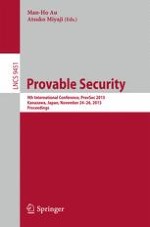2015 | OriginalPaper | Buchkapitel
Black-Box Separations of Hash-and-Sign Signatures in the Non-Programmable Random Oracle Model
verfasst von : Zongyang Zhang, Yu Chen, Sherman S. M. Chow, Goichiro Hanaoka, Zhenfu Cao, Yunlei Zhao
Erschienen in: Provable Security
Aktivieren Sie unsere intelligente Suche, um passende Fachinhalte oder Patente zu finden.
Wählen Sie Textabschnitte aus um mit Künstlicher Intelligenz passenden Patente zu finden. powered by
Markieren Sie Textabschnitte, um KI-gestützt weitere passende Inhalte zu finden. powered by
